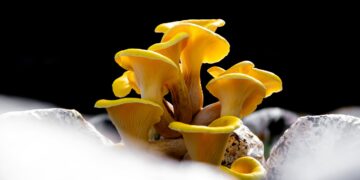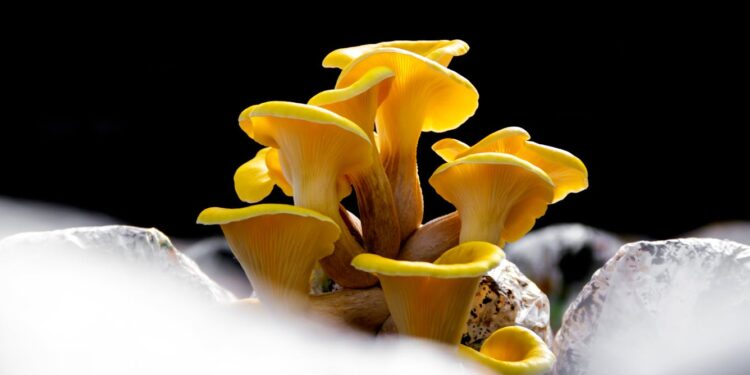Login to Continue Learning
Golden oyster mushrooms, known for their sunny yellow caps and nutty flavor, have become popular due to their health benefits, taste, and ease of cultivation at home. However, this popularity has led to an invasive species problem in the wild. New research shows that these fungi are pushing out native fungi.
In a study believed to be the first of its kind, mycologists demonstrated that an invasive fungus can cause environmental harm, similar to how invasive plants and animals disrupt ecosystems.
A scientist documents golden oyster mushrooms growing wild in a Wisconsin forest, where these invasive fungi don’t belong. DNA tests showed the species had displaced other native fungi.
Native mushrooms and other fungi are crucial for ecosystem health. They break down dead wood and plant material, helping it decay. They cycle nutrients like carbon and nitrogen from dead tissues into usable forms that enter the soil or atmosphere. Fungi also play a role in managing climate change by sequestering carbon in soil and mediating carbon emissions from soil and wood.
Their symbiotic relationships with other organisms help those organisms thrive. Mycorrhizal fungi on roots, for example, aid plants in absorbing water and nutrients. Wood decay fungi create habitats for birds, mammals, and plant seedlings.
However, our study found that invasive golden oyster mushrooms, a wood decay fungus, can threaten forests’ fungal biodiversity and harm ecosystems already vulnerable to climate change and habitat destruction.
The Dark Side of the Mushroom Trade
Golden oyster mushrooms, native to Asia, were introduced to North America around the early 2000s. They are part of an international mushroom culinary craze that has contributed to one of the world’s leading drivers of biodiversity loss: invasive species.
Fungi are moved globally through trade, either intentionally as products like grow kits or unintentionally along with soil, plants, timber, and shipping pallets. Golden oyster mushrooms have been particularly problematic.
Many mushroom species have been cultivated in North America for decades without becoming invasive threats. However, golden oyster mushrooms stand out.
No one knows exactly how golden oyster mushrooms escaped into the wild—whether from grow kits, commercial farms, or outdoor logs inoculated with golden oysters—a home-cultivation technique where mushroom mycelium is placed into logs to colonize the wood and produce mushrooms.
As grow kits increased in popularity, many people began growing golden oyster mushrooms in their backyards. Their spores or composted kits could have spread into nearby forests. Evidence suggests these mushrooms were introduced into the wild in multiple U.S. states around the early 2010s.
Species Golden Oysters Push Out
In our study, we collected wood shavings from dead trees to analyze the natural fungal communities within each tree. Some trees had golden oyster mushrooms, and some did not. We then extracted DNA to identify and compare which fungi were present in trees with golden oyster mushrooms versus those without.
We found that trees with golden oyster mushrooms housed only half as many fungal species as trees without these mushrooms, sometimes even less. The composition of fungi was also different between the two groups.
For example, the gentle green mossy maze polypore and the elm oyster mushroom were pushed out from trees invaded by golden oyster mushrooms.
Another ousted fungus, known for producing diverse arrays of chemicals, is a potential source of revolutionary medicines like antibiotics, cholesterol medication, and organ transplant stabilizers. The value of undiscovered, potentially useful chemicals can be lost when invasive species push others out.
The Invasive Species Problem Includes Fungi
Given our findings, we believe it’s time to include invasive fungi in the global conversation about invasive species. That conversation includes the idea of fungal “endemism” – that each place has a native fungal community that can be thrown out of balance. Our research shows how invasive species change the makeup of fungal communities by outcompeting native species, thus changing the processes that have shaped native ecosystems.
There are many other invasive fungi. For example, the deadly poisonous death cap and the orange ping-pong bat are invasive in North America. The classic red and white fly agaric is native to North America but invasive elsewhere.
The golden oyster mushrooms’ invasion of North America should serve as a warning that nonnative fungi can rapidly invade and should be cultivated with caution, if at all. Golden oyster mushrooms are now recognized as invasive in Switzerland and found in forests in Italy, Hungary, Serbia, and Germany. I have heard about people attempting to cultivate them around the world.
Mushroom growers, businesses, and foragers may ask what they can do. For now, consider refraining from using golden oyster mushroom grow kits to prevent new introductions. If you make a living selling these mushrooms, add a note that this species is invasive and should be cultivated indoors and not composted. Try cultivating safe, native species in your region.
There is no single right answer. Golden oyster mushrooms are being cultivated as a food source for impoverished communities or to process agricultural waste and produce food at the same time. Positives like these will have to be considered alongside the mushrooms’ negative impacts when developing management plans or legislation.
In the future, solutions could involve sporeless strains of golden oysters for home kits that can’t spread, or a targeted mycovirus to control the population. Increased awareness about responsible cultivation practices is important because when invasive species disrupt native biodiversity, we all lose the beautiful, colorful, and strange fungi we see on walks in the forest.


















